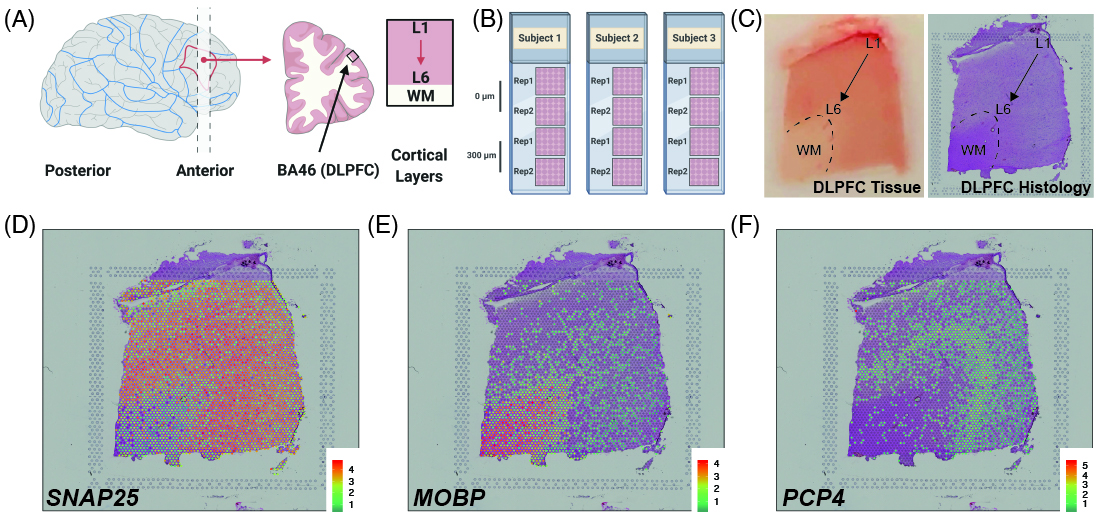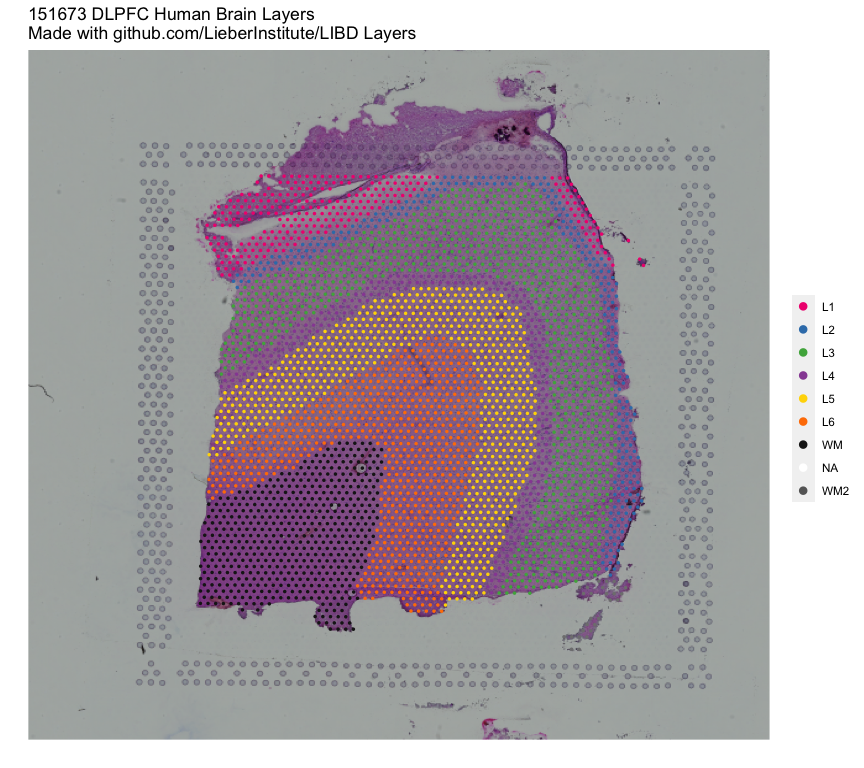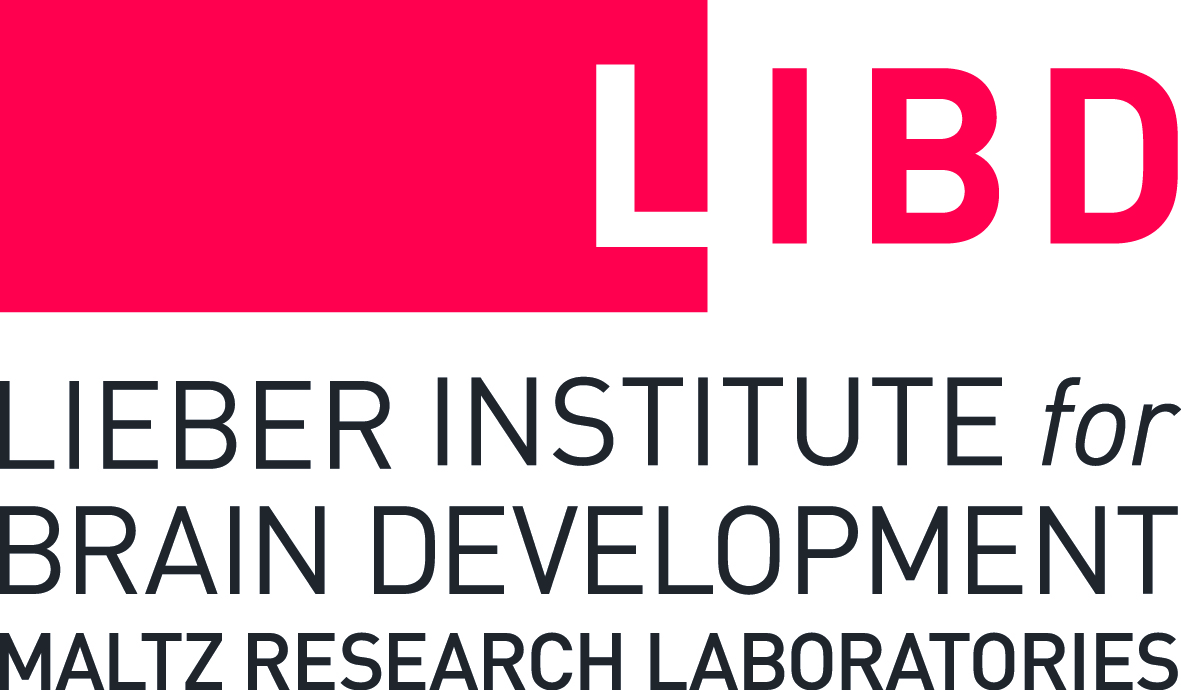Welcome to the spatialLIBD project! It is composed of:
- a shiny web application that we are hosting at spatial.libd.org/spatialLIBD/ that can handle a limited set of concurrent users,
- a Bioconductor package at bioconductor.org/packages/spatialLIBD (or from here) that lets you analyze the data and run a local version of our web application (with our data or yours),
- and a research article with the scientific knowledge we drew from this dataset. The analysis code for our project is available here and the high quality figures for the manuscript are available through Figshare.
The web application allows you to browse the LIBD human dorsolateral pre-frontal cortex (DLPFC) spatial transcriptomics data generated with the 10x Genomics Visium platform. Through the R/Bioconductor package you can also download the data as well as visualize your own datasets using this web application. Please check the manuscript or bioRxiv pre-print for more details about this project.
If you tweet about this website, the data or the R package please use
the #spatialLIBD hashtag. You can find previous tweets that
way as shown
here.
Thank you!
Tweet
#spatialLIBD
As a quick overview, the data presented here is from portion of the DLPFC that spans six neuronal layers plus white matter (A) for a total of three subjects with two pairs of spatially adjacent replicates (B). Each dissection of DLPFC was designed to span all six layers plus white matter (C). Using this web application you can explore the expression of known genes such as SNAP25 (D, a neuronal gene), MOBP (E, an oligodendrocyte gene), and known layer markers from mouse studies such as PCP4 (F, a known layer 5 marker gene).
This web application was built such that we could annotate the spots to layers as you can see under the spot-level data tab. Once we annotated each spot to a layer, we compressed the information by a pseudo-bulking approach into layer-level data. We then analyzed the expression through a set of models whose results you can also explore through this web application. Finally, you can upload your own gene sets of interest as well as layer enrichment statistics and compare them with our LIBD Human DLPFC Visium dataset.
If you are interested in running this web application locally, you can
do so thanks to the spatialLIBD R/Bioconductor package that powers
this web application as shown below.
## Run this web application locally
spatialLIBD::run_app()
## You will have more control about the length of the
## session and memory usage.
## You could also use this function to visualize your
## own data given some requirements described
## in detail in the package vignette documentation
## at http://research.libd.org/spatialLIBD/.The spatialLIBD package contains functions for:
- Accessing the spatial transcriptomics data from the LIBD Human Pilot
project (code on
GitHub) generated
with the Visium platform from 10x Genomics. The data is retrieved
from Bioconductor’s
ExperimentHub. - Visualizing the spot-level spatial gene expression data and clusters.
- Inspecting the data interactively either on your computer or through spatial.libd.org/spatialLIBD/.
For more details, please check the documentation website or the Bioconductor package landing page here.
Get the latest stable R release from
CRAN. Then install spatialLIBD from
Bioconductor using the following code:
if (!requireNamespace("BiocManager", quietly = TRUE)) {
install.packages("BiocManager")
}
BiocManager::install("spatialLIBD")If you want to use the development version of spatialLIBD, you will
need to use the R version corresponding to the current
Bioconductor-devel branch as described in more detail on the
Bioconductor
website. Then you
can install spatialLIBD from GitHub using the following command.
BiocManager::install("LieberInstitute/spatialLIBD")Through the spatialLIBD package you can access the processed data in
it’s final R format. However, we also provide a table of links so you
can download the raw data we received from 10x Genomics.
Using spatialLIBD you can access the Human DLPFC spatial
transcriptomics data from the 10x Genomics Visium platform. For example,
this is the code you can use to access the layer-level data. For more
details, check the help file for fetch_data().
## Load the package
library("spatialLIBD")
## Download the spot-level data
spe <- fetch_data(type = "spe")
## This is a SpatialExperiment object
spe
#> class: SpatialExperiment
#> dim: 33538 47681
#> metadata(0):
#> assays(2): counts logcounts
#> rownames(33538): ENSG00000243485 ENSG00000237613 ... ENSG00000277475
#> ENSG00000268674
#> rowData names(9): source type ... gene_search is_top_hvg
#> colnames(47681): AAACAACGAATAGTTC-1 AAACAAGTATCTCCCA-1 ...
#> TTGTTTCCATACAACT-1 TTGTTTGTGTAAATTC-1
#> colData names(69): sample_id Cluster ... array_row array_col
#> reducedDimNames(6): PCA TSNE_perplexity50 ... TSNE_perplexity80
#> UMAP_neighbors15
#> mainExpName: NULL
#> altExpNames(0):
#> spatialCoords names(2) : pxl_col_in_fullres pxl_row_in_fullres
#> imgData names(4): sample_id image_id data scaleFactor
## Note the memory size
lobstr::obj_size(spe) / 1024^3 ## Convert to GB
#> 1.899369 B
## Remake the logo image with histology information
vis_clus(
spe = spe,
clustervar = "spatialLIBD",
sampleid = "151673",
colors = libd_layer_colors,
... = " DLPFC Human Brain Layers\nMade with github.com/LieberInstitute/spatialLIBD"
)You can access all the raw data through
Globus (jhpce#HumanPilot10x).
Furthermore, below you can find the links to the raw data we received
from 10x Genomics.
| SampleID | h5_filtered | h5_raw | image_full | image_hi | image_lo | loupe | HTML_report |
|---|---|---|---|---|---|---|---|
| 151507 | AWS | AWS | AWS | AWS | AWS | AWS | GitHub |
| 151508 | AWS | AWS | AWS | AWS | AWS | AWS | GitHub |
| 151509 | AWS | AWS | AWS | AWS | AWS | AWS | GitHub |
| 151510 | AWS | AWS | AWS | AWS | AWS | AWS | GitHub |
| 151669 | AWS | AWS | AWS | AWS | AWS | AWS | GitHub |
| 151670 | AWS | AWS | AWS | AWS | AWS | AWS | GitHub |
| 151671 | AWS | AWS | AWS | AWS | AWS | AWS | GitHub |
| 151672 | AWS | AWS | AWS | AWS | AWS | AWS | GitHub |
| 151673 | AWS | AWS | AWS | AWS | AWS | AWS | GitHub |
| 151674 | AWS | AWS | AWS | AWS | AWS | AWS | GitHub |
| 151675 | AWS | AWS | AWS | AWS | AWS | AWS | GitHub |
| 151676 | AWS | AWS | AWS | AWS | AWS | AWS | GitHub |
Below is the citation output from using citation('spatialLIBD') in R.
Please run this yourself to check for any updates on how to cite
spatialLIBD.
print(citation("spatialLIBD"), bibtex = TRUE)
#>
#> Pardo B, Spangler A, Weber LM, Hicks SC, Jaffe AE, Martinowich K,
#> Maynard KR, Collado-Torres L (2021). "spatialLIBD: an R/Bioconductor
#> package to visualize spatially-resolved transcriptomics data."
#> _bioRxiv_. doi: 10.1101/2021.04.29.440149 (URL:
#> https://doi.org/10.1101/2021.04.29.440149), <URL:
#> https://www.biorxiv.org/content/10.1101/2021.04.29.440149v1>.
#>
#> A BibTeX entry for LaTeX users is
#>
#> @Article{,
#> title = {spatialLIBD: an R/Bioconductor package to visualize spatially-resolved transcriptomics data},
#> author = {Brenda Pardo and Abby Spangler and Lukas M. Weber and Stephanie C. Hicks and Andrew E. Jaffe and Keri Martinowich and Kristen R. Maynard and Leonardo Collado-Torres},
#> year = {2021},
#> journal = {bioRxiv},
#> doi = {10.1101/2021.04.29.440149},
#> url = {https://www.biorxiv.org/content/10.1101/2021.04.29.440149v1},
#> }
#>
#> Maynard KR, Collado-Torres L, Weber LM, Uytingco C, Barry BK, Williams
#> SR, II JLC, Tran MN, Besich Z, Tippani M, Chew J, Yin Y, Kleinman JE,
#> Hyde TM, Rao N, Hicks SC, Martinowich K, Jaffe AE (2021).
#> "Transcriptome-scale spatial gene expression in the human dorsolateral
#> prefrontal cortex." _Nature Neuroscience_. doi:
#> 10.1038/s41593-020-00787-0 (URL:
#> https://doi.org/10.1038/s41593-020-00787-0), <URL:
#> https://www.nature.com/articles/s41593-020-00787-0>.
#>
#> A BibTeX entry for LaTeX users is
#>
#> @Article{,
#> title = {Transcriptome-scale spatial gene expression in the human dorsolateral prefrontal cortex},
#> author = {Kristen R. Maynard and Leonardo Collado-Torres and Lukas M. Weber and Cedric Uytingco and Brianna K. Barry and Stephen R. Williams and Joseph L. Catallini II and Matthew N. Tran and Zachary Besich and Madhavi Tippani and Jennifer Chew and Yifeng Yin and Joel E. Kleinman and Thomas M. Hyde and Nikhil Rao and Stephanie C. Hicks and Keri Martinowich and Andrew E. Jaffe},
#> year = {2021},
#> journal = {Nature Neuroscience},
#> doi = {10.1038/s41593-020-00787-0},
#> url = {https://www.nature.com/articles/s41593-020-00787-0},
#> }Please note that the spatialLIBD was only made possible thanks to many
other R and bioinformatics software authors, which are cited either in
the vignettes and/or the paper(s) describing this package.
Please note that the spatialLIBD project is released with a Contributor Code of Conduct. By contributing to this project, you agree to abide by its terms.
- Continuous code testing is possible thanks to GitHub actions through usethis, remotes, sysreqs and rcmdcheck customized to use Bioconductor’s docker containers and BiocCheck.
- Code coverage assessment is possible thanks to codecov and covr.
- The documentation website is automatically updated thanks to pkgdown.
- The code is styled automatically thanks to styler.
- The documentation is formatted thanks to devtools and roxygen2.
For more details, check the dev directory.
This package was developed using biocthis.
<script type='text/javascript' id='clustrmaps' src='//cdn.clustrmaps.com/map_v2.js?cl=ffffff&w=300&t=n&d=FRs8oQ9HVpMg6QLJJKAExpF8seGfPVlH-YOnwqUE8Hg'></script> <script async src="https://www.googletagmanager.com/gtag/js?id=UA-159132967-1"></script> <script> window.dataLayer = window.dataLayer || []; function gtag(){dataLayer.push(arguments);} gtag('js', new Date());gtag('config', 'UA-159132967-1'); </script>





